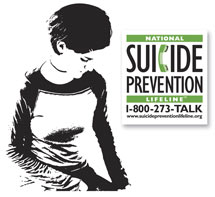Depression, Substance Abuse: Significant Risk Factors
for Suicide
 Suicide
is the 11th leading cause of death among adults and is
considered a major public health problem. But those who
die from suicide represent only a fraction of those who
consider or attempt suicide, according to a new Office
of Applied Studies report from SAMHSA. Suicide
is the 11th leading cause of death among adults and is
considered a major public health problem. But those who
die from suicide represent only a fraction of those who
consider or attempt suicide, according to a new Office
of Applied Studies report from SAMHSA.
For those with a major depressive episode (MDE) who
also engaged in alcohol or drug abuse, the likelihood
of suicide attempts or suicidal thoughts is even greater.
According to the new short report from SAMHSA, Suicidal
Thoughts, Suicide Attempts, Major Depressive Episode,
and Substance Use among Adults, 10.4 percent
(1.7 million people) of adults age 18 or older who experienced
an MDE made a suicide attempt, 14.5 percent (2.4 million
people) made a suicide plan, 40.3 percent (6.6 million
people) thought about committing suicide, and 56.3 percent
(9.2 million people) thought that it would be better
if they were dead.
When alcohol abuse—particularly binge drinking
or the use of illicit drugs—is added to an MDE,
the proportion of suicide attempts rises to nearly 14
percent for alcohol abuse and nearly 20 percent for illicit
drug use.
“These new findings show the scope of the problem
and underscore the importance of suicide prevention efforts,”
said Assistant Surgeon General Eric B. Broderick, D.D.S.,
M.P.H., SAMHSA’s Acting Deputy Administrator. “For
people in crisis, the National Suicide Prevention Lifeline
at 1 (800) 273-TALK offers immediate assistance.”
The report also found that, in 2004, an estimated 106,000
visits to emergency departments were attributable to
suicide attempts. A mental disorder was diagnosed in
41 percent of the drug-related suicide attempts treated
in emergency rooms; the foremost of these disorders was
depression.
These data were released during Suicide Prevention Week
2006—September 10 to September 16. The report is
available for free download on SAMHSA’s Web site
at http://oas.samhsa.gov/
2k6/suicide/suicide.cfm.
Back to Top
Action Alliance
To further support suicide prevention efforts, SAMHSA
recently announced that the Suicide Prevention Action
Network (SPAN USA), a national suicide prevention organization,
will join with the Agency to establish and administer
the National Action Alliance for Suicide Prevention.
The Action Alliance, a public-private partnership, will
reframe the goals and objectives of the National Strategy
for Suicide Prevention from paper to practice. Measurable
actions will be generated for Government, industry, general
and specialty health care sectors, academia, communities,
and consumers and families.
The creation of this Action Alliance was one of the
key recommendations of the National Strategy for Suicide
Prevention (2001), the President’s New Freedom
Commission on Mental Health (2003), and the Federal Mental
Health Action Agenda (2005), a recommendation echoed
by Congress in 2005.
In addition, SAMHSA recently announced the award of
46 grants totaling $25.7 million to support other activities,
including grants funded under the Garrett Lee Smith Memorial
Act for youth suicide prevention. The grants support
initiatives by states and on college campuses to prevent
suicide and to enhance services for youth depression,
other mental health problems, and substance abuse, which
put young people at risk for suicide. (See grant
and press
release.) 
« Previous Article
See Also—Next Article »
Back to Top
|




